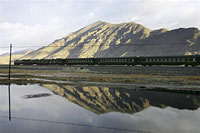




Residents of Lhasa say they have seen little benefit from a new U.S. $5 billion railway connecting the Tibetan capital with the Chinese frontier city of Golmud, a year after its completion and in spite of strong economic growth in the region.
“Since the opening of Qinghai-Lhasa railway on July 1, 2006, I and all other Tibetans in Lhasa have been overwhelmed by the frightful explosion of the Chinese population in the city,” a woman caller from Lhasa who identified herself as Dadon told RFA’s Tibetan service.
“In Lhasa, wherever you go, you get the impression of overcrowding, whether in the markets, the bus stations, or holy sites. Even the railway stations seem to be full of people,” Dadon said.
The joy and excitement reported in the Chinese-controlled official media are “out of the question.”
More than 1 million tourists traveled to Tibet in the first six months of the year, a rise of 86.3 percent over the same period a year earlier, local tourism figures show.
In Lhasa, wherever you go, you get the impression of overcrowding,
According to the state news agency Xinhua, tourists brought 990.3 million yuan (U.S. $130 million) in revenue to the Himalayan region, an increase of 92.1 percent from the year before, the agency quoted statistics from the tourism bureau of the Tibet Autonomous Region as saying.
It added that of the 1.1 million tourists, just 73,000 were from overseas, and they spent U.S. $24 million.
Tourism officials attribute the growth in tourist numbers to promotional efforts and the Qinghai-Tibet Railway, which began operation on July 1, 2006, Xinhua said.
The railway has also slashed the cost of distribution of goods moving in and out of the region, which saw an economic growth rate of 14.7 percent in the first half of the year, the highest over the past decade.
Gross domestic product (GDP) reached 14 billion yuan (U.S. $1.84 billion) in the first six months of 2007, 2.2 percentage points higher than the same period of last year, according to the Tibet Regional Statistics Bureau. It cited the fastest growth rates in the industrial and service sectors, areas that typically draw large numbers of Han Chinese.
Dadon said ordinary Tibetans had seen little benefit from the railway, however.
“If the railway brought progress for us, we could be happy and excited but that is not happening. We are worried. There could be some benefits, such as more business for the Tibetan traders, but those are insignificant if you take the whole picture of Chinese benefits in terms of business and employment into account,” she said.
“We have personally witnessed the Chinese tourists becoming permanent residents,” she said, adding that Han Chinese migrants were moving fast into formerly Tibetan neighborhoods and businesses.
Another caller, a Tibetan man from Lhasa, agreed: “Despite all the Chinese propaganda, there is deep skepticism about the aim and whose purpose it is serving,” he told RFA. “The Tibetans are certainly not the direct beneficiaries.”
“Now many Tibetan residents in Lhasa are very apprehensive about the explosion of Chinese population. They feel and realize that the Tibetan population is being driven into the minority, and is becoming a powerless segment of society.”
A Tibetan-American student recently back from the region praised the high standards on board the train, which reportedly employs few Tibetans. But she saw few Tibetans among its passengers.
“About 98 per cent of passengers in the train that we traveled on were Chinese. They could be tourists or seeking jobs or starting businesses in Lhasa. We got the impression that most of them were going for jobs in Tibet,” she said.
The world’s highest railway line linking the Tibetan capital of Lhasa to the rest of China carried 1.5 million passengers into Tibet in its first year.
This year, Tibet expects to host three million tourists bringing in 3.4 billion yuan (U.S. $447 million), according to the regional development and reform commission.
Original reporting by Dolkar for RFA’s Tibetan service. Translated by Karma Dorjee. Edited for the Web by Luisetta Mudie and Sarah Jackson-Han.